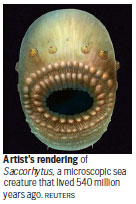

It's been said that the ancient Greek philosopher Aristotle invented Western science by having his students collect sea shells on the beach and then sort them by their features, looking for connections.
If that's true, his helpers would surely be scratching their heads over the remains of some critters just unearthed in China.
Researchers have identified traces of what could be the earliest known prehistoric ancestor of not just humans, but of all bilaterally symmetrical creatures with a backbone. And you'd never know it to look at it.
Named Saccorhytus, the microscopic, bag-like sea creature lived about 540 million years ago. Shaped like a tiny grape, it had a huge mouth relative to the rest of its body and probably ate by engulfing its food or other creatures.
Its skin (like a human's) was thin and flexible and it lived in the sand bed of a shallow sea, wiggling to get around.
Its features were spectacularly well preserved in the fossils, including cone-shaped "vents" along its sides that may be precursors of gills. Intriguingly, the researchers were unable to find any evidence that the animal had an anus and suggest it discarded its waste back out through its mouth.
The species is all new to science and is thought to be the most primitive example of the broad biological category called deuterostome, according to the paper just published in Nature.
The study was carried out by an international team of academics, including researchers from Northwest University in Xi'an and the University of Cambridge in the UK, with support from other institutions in China and Germany.
"We think that as an early deuterostome this may represent the primitive beginnings of a very diverse range of species, including ourselves," said Simon Conway Morris, professor of evolutionary palaeobiology at Cambridge. "To the naked eye, the fossils we studied look like tiny black grains, but under the microscope the level of detail is jaw-dropping. All deuterostomes had a common ancestor, and we think that is what we are looking at here."
Degan Shu, from Xi'an's Northwest University, added: "Our team has notched up some important discoveries in the past, including the earliest fish and a remarkable variety of other early deuterostomes. Saccorhytus now gives us remarkable insights into the very first stages of the evolution of a group that led to the fish, and ultimately, to us."
Not just to fish but creatures as diverse as starfish and sea urchins, so this little creature's reach embraces a level of diversity scientists had previously found extremely difficult to connect the dots on.
The Saccorhytus microfossils were found in Central China's Shaanxi province in an area that during the Cambrian Period would have been a shallow sea. Scientists isolated the fossils from surrounding rock and then studied them under both electron microscopes and CT scans.
"We had to process enormous volumes of limestone - about three tons - to get to the fossils," said Dr Jian Han, of Northwest University. "But a steady stream of new finds allowed us to tackle some key questions: was this a very early echinoderm (starfish, sea urchin or sea cucumber), or something even more primitive? The latter now seems to be the correct answer."
The new findings also throw light on one of the most esoteric discrepancies in modern science - the mismatch between fossil evidence and the so-called "molecular clock" provided by modern genetic analysis.
Scientists believe that two species diverging from a common ancestor leave a time trail in their DNA and many of these "tracks" suggest how far back life went. The problem has been, most forms of life back half a billion years were too small to leave fossils.
This remarkable find could help bridge the gap between the two methods of sleuthing for answers. Aristotle would give it an A plus.
Contact the writer at chrisdavis@chinadailyusa.com.
Flatiron buildings offer degree of recognition in far-flung cities